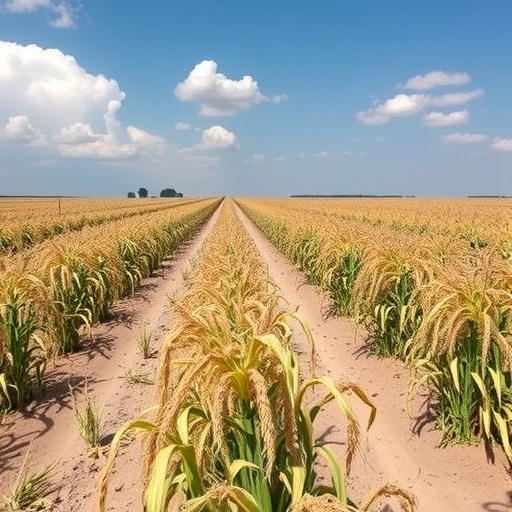In a landmark study poised to reshape our understanding of crop resilience under the mounting pressures of climate change, researchers at the University of Illinois Urbana-Champaign and the U.S. Department of Agriculture’s Agricultural Research Service have revealed a stark truth: drought conditions do not shield soybean plants from the detrimental effects of ozone pollution. This revelation challenges prior hypotheses suggesting that drought-induced stomatal closure in plants might act as a protective barrier against ozone influx, ultimately damaging key physiological processes that determine crop productivity.
Soybean, a critical global crop serving as a major protein and oil source, faces a double threat as drought frequency and surface ozone levels both rise due to anthropogenic climate shifts. The study meticulously employed the SoyFACE (Soybean Free Air Concentration Enrichment) experimental facility, the world’s foremost platform for manipulating atmospheric composition in open-field settings, to simulate realistic environmental conditions. Over three growing seasons, soybeans were exposed to ozone concentrations of approximately 100 parts per billion, reflective of peak summer pollution levels observed in key agricultural belts of Asia, particularly China and India, while concurrently experiencing a significant reduction in ambient rainfall by nearly 40%.
The agricultural community has long debated the interplay between drought stress and ozone damage. The underlying premise revolved around the behavior of stomata — microscopic apertures on leaf surfaces that regulate gas exchange. Under water scarcity, plants close stomata to preserve vital moisture, which theoretically should reduce ozone entry. However, the current research definitively shows that despite stomatal responses to drought, elevated ozone infiltrates leaf tissues and inflicts substantial damage, culminating in reduced photosynthetic efficiency and lower soybean yields.
Delving deeper into the physiological mechanisms, the investigators scrutinized the role of abscisic acid (ABA), a key hormone implicated in plant drought signaling. The hormone facilitates communication between roots and leaves, orchestrating stomatal closure in response to soil moisture status. Contrary to some predictions that ozone might impair ABA signaling and keep stomata open, the data indicated a robust linear correlation between soil moisture and ABA concentration regardless of ozone levels, suggesting that ozone does not hinder the plant’s intrinsic drought response pathway.
Despite functional ABA signaling and stomatal adjustments, ozone’s deleterious effects persisted, raising crucial questions about how oxidative damage proceeds. Part of the explanation lies in the incomplete closure of stomata; even under severe drought, stomatal pores do not fully seal, allowing ozone molecules to penetrate. Once inside the leaf, ozone quickly reacts to form reactive oxygen species (ROS), highly reactive molecules capable of disrupting cellular structures and triggering defensive genetic programs. Under elevated ozone concentrations, such stress responses intensify, occasionally resulting in the hypersensitive response whereby cells undergo programmed death as a means of containing damage.
One of the most concerning aspects of this work is the discrepancy between the ozone thresholds for damage identified in the study and typical ozone levels experienced in regions like the U.S. Corn Belt. Although the experimental concentration of 100 parts per billion exceeds those commonly observed in the United States, damage to soybean crops begins at much lower concentrations, near 40 parts per billion. Given that seasonal ozone in the Corn Belt frequently breaches this damage threshold and is anticipated to rise by 2070, the findings spotlight a looming threat to staple crop yields in the heartland of U.S. agriculture.
Further complicating mitigation efforts is the subtlety of ozone damage manifestation. Farmers may mistakenly attribute leaf bronzing, necrosis, or reduced yield to pathogens or nutrient deficiencies, potentially overlooking pervasive ozone stress. Enhanced awareness and targeted breeding for ozone tolerance will be crucial to safeguarding soybean productivity amid the twin challenges of drought and air pollution.
The SoyFACE facility’s unique ability to recreate field-relevant atmospheric conditions without confounding environmental variables underscores the robustness of the conclusions drawn from this study. Unlike growth chambers or greenhouse experiments that often fail to capture the complexity of field environments, SoyFACE ensures fidelity in simulating real-world scenarios, thereby elevating confidence in the translational relevance of findings to agricultural systems.
Elevated ozone not only compromised photosynthetic efficiency by damaging chloroplasts and associated enzymatic machinery but also consistently reduced seed size and number, directly curtailing crop yield. This persistent reduction in productivity, irrespective of drought presence, signals that ozone tolerance must be elevated as a primary target for future crop improvement programs. Yield stability under abiotic stressors is paramount for global food security, and this study highlights ozone as a critical, yet often underappreciated, factor.
Lisa Ainsworth, the study’s co-author and distinguished crop physiologist at the University of Illinois, emphasizes the actionable nature of these insights. Because ozone is a short-lived pollutant predominantly formed by ground-level photochemical reactions involving precursors such as nitrogen oxides and volatile organic compounds, regulatory and technological interventions can rapidly reduce ambient concentrations. This contrasts with more persistent climate factors, positioning ozone mitigation as an immediate opportunity to bolster agricultural resilience and increase yields on relatively short timescales.
In summary, this ground-breaking research decisively refutes the notion that drought conditions confer protection against ozone toxicity in soybeans. Instead, it reveals an unnerving synergy where ozone manages to inflict damage even as plants activate their natural drought defenses. The implications ripple beyond academic curiosity, demanding urgent integration of ozone considerations in agricultural management, breeding strategies, and environmental policy formulations aimed at securing crop productivity in a changing world.
Subject of Research: Effects of elevated ozone and drought on soybean physiology and yield
Article Title: Drought does not mitigate reductions in soybean photosynthesis and yield caused by elevated ozone
Web References:
References:
- Ainsworth, L. et al. “Drought does not mitigate reductions in soybean photosynthesis and yield caused by elevated ozone,” Plant Physiology, DOI: 10.1093/plphys/kiaf350.
Image Credits: Photo by Duncan Martin, SoyFACE facility, University of Illinois Urbana-Champaign
Keywords: Soybean, ozone pollution, drought stress, photosynthesis, stomata, abscisic acid, crop yield, climate change, oxidative stress, plant physiology, Free Air Concentration Enrichment, agricultural resilience




